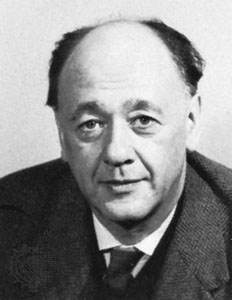 |
 (1909–1994) |

|
|
b. Nov. 26, 1909, Slatina, Romania d. March 28, 1994, Paris, France "Romanian-born French playwright. He studied in Bucharest and Paris, where he lived from 1945. His first one-act “antiplay,” The Bald Soprano (1950), inspired a revolution in dramatic techniques and helped inaugurate the Theatre of the Absurd. He followed it with other one-act plays in which illogical events create an atmosphere both comic and grotesque, including The Lesson (1951), The Chairs (1952), and The New Tenant (1955). His most popular full-length play, Rhinoceros (1959), concerns a provincial French town in which all the citizens are metamorphosing into rhinoceroses. Other plays include Exit the King (1962) and A Stroll in the Air (1963). He was elected to the Académie Française in 1970." (ENCYCLOPÆDIA BRITANNICA) |
 1959 |

"Though best known as a playwright, plays were not his first chosen medium. He started writing poetry and criticism, publishing in several Romanian journals. Two early writings of note are Nu, a book criticizing many other writers including prominent Romanian poets, and Hugoliade, or, The grotesque and tragic life of Victor Hugo a satirical biography mocking Victor Hugo's status as a great figure in French literature. The Hugoliade includes exaggerated retellings of the most scandalous episodes in Hugo's life and contains prototypes for many of Ionesco's later themes: the ridiculous authoritarian character, the false worship of language.
Ionesco's earliest works, and his most innovative, were one-act nonsense plays: La Cantatrice chauve (1950), La Leçon translated as The Lesson (1951), Les Chaises translated as The Chairs (1952), and Jacques ou la Soumission translated as Jack, or: The Submission (1955). These absurdist sketches, to which he gave such descriptions as "anti-play" (anti-pièce in French) express modern feelings of alienation and the impossibility and futility of communication with surreal comic force, parodying the conformism of the bourgeoisie and conventional theatrical forms. In them Ionesco rejects a conventional story-line as their basis, instead taking their dramatic structure from accelerating rhythms and/or cyclical repetitions. He disregards psychology and coherent dialogue, thereby depicting a dehumanized world with mechanical, puppet-like characters who speak in non-sequiturs. Language becomes rarefied, with words and material objects gaining a life of their own, increasingly overwhelming the characters and creating a sense of menace."
(WIKIPEDIA.ORG)
Ionesco's grave in Montparnasse cemetery, Paris. The inscription translates: Pray to the I don't-know-who: Jesus Christ, I hope
Any comments??
Please use the following link: Message Board
 Dracula's Live Radio
Dracula's Live Radio